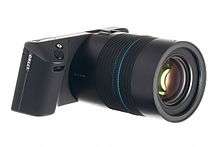Lytro
 Lytro ILLUM light field camera from 2014 | |
| Private | |
| Industry | Digital cameras |
| Founded | 2006 |
| Founder | Ren Ng |
Key people | Ren Ng, Executive Chairman; Kurt Akeley, CTO; Jason Rosenthal, CEO |
| Products | Light-field camera |
| Website |
lytro |
Lytro, Inc. is an American company founded in 2006 by Ren Ng which develops light-field cameras.[1][2][3][4] Lytro began shipping its first generation pocket-sized camera, capable of refocusing images after being taken, in 8 GB and 16 GB versions on February 29, 2012.[5][6][7][8] In April 2014, the company announced Lytro ILLUM, its second generation camera for commercial and experimental photographers.[9] The Lytro ILLUM was released at $1,600.[10] The ILLUM has a permanently attached 30–250mm (35mm equivalent) f/2.0 lens and an articulated rear screen.[11] In the fall of 2015, Lytro changed direction, announcing Immerge, a very-high-end VR video capture camera with companion custom compute server. Immerge is expected to ship in 2016, and be useful to studios trying to combine CGI-based VR with video VR.[12]
History

While he was a researcher at Stanford, Ren Ng was photographing a friend's daughter and noticed, "it was incredibly difficult to focus the image properly and capture her fleeting smile in just the right way".[13] After completing his Ph.D, Ng decided to use his experience in light field research to "start a company that would produce light-field cameras that everyone could enjoy."[13] The company was originally named Refocus Imaging, before launching as Lytro.
Lytro board members include Ben Horowitz, general partner at Andreessen Horowitz; Patrick Chung, partner at NEA; and TiVo cofounder Mike Ramsay,[14] with Charles Chi of Greylock Partners serving as Executive Chairman.[15] Advisors include Intuit cofounder Scott Cook, VMware cofounder Diane Greene, Dolby Labs chairman Peter Gotcher and Sling Media cofounder Blake Krikorian.[14]
Lytro founder Ng was Lytro's first CEO. Lytro’s Chief Technology Officer Kurt Akeley was a founding member of Silicon Graphics.[15] In June 2012 Ng announced that he would be changing roles and be Lytro's Executive Chairman focused on innovation. Charles Chi would change from Executive Chairman to interim CEO while Lytro's board begins looking for a new CEO.
In June 2011, Apple Inc CEO Steve Jobs purportedly met with Ng to discuss improvements for the iPhone camera.[16]
Although not a true light field camera, the HTC One (M8) mobile phone released in April 2014 mimics Lytro's depth-sensing functionality through the use of a second camera and stereoscopic post processing.[17]
Products
Original Lytro Light Field Camera
The original camera is a square tube less than five inches long with a lens opening at one end and a 1.52" LCD touch screen at the other. The first generation of the camera comes in two options: one with 8GB of memory (which can hold 350 pictures) and one with 16GB (which can hold 750 pictures).[8][18][19][20]
Lytro ILLUM
The Lytro ILLUM features a 40 megaray sensor (in comparison to the original Lytro Camera's 11 megaray sensor), and a more powerful processor. The 30-250mm lens has 8.3x optical zoom, an f/2.0 aperture, and 1:3 macro focus capability. The lens was designed to weigh half a pound to make the camera lighter and more agile. The ILLUM features a 1,152,000 pixel articulated 4" LCD touchscreen with a wide aspect ratio. A display overlay shows the photographer the relative focus of all objects in the frame, and which elements are re-focusable. The camera has an SD/SDHC/SDXC card slot and no internal storage. It also features a USB 3.0 port, external shutter release port, hot shoe, tripod mount, and removable battery. The CMOS image sensor measures 1/2" (6.4 x 4.8 mm) and the sensitvity can be varied from ISO 80 to 3200.

Lytro Immerge
On November 5, 2015, Lytro announced Immerge, an end-to-end system for capturing light fields for use in creating Virtual reality(VR) content. [24]
Investment
Funding Received: $140 Million in 4 Rounds from 8 Investor
Most Recent Funding: $50 Million Venture on February 25, 2015 [25]
Technology
Light-field photography (also known as plenoptic photography) captures information about the intensity of light in a scene, and also captures information about the direction that the light rays are traveling in space. Lytro's light field sensor uses an array of micro-lenses placed in front of an otherwise conventional image sensor; to sense intensity, color, and directional information.[26] Software then uses this data to create displayable 2D or 3D images.[27] Lytro trades maximum 2D resolution, at a given distance, for enhanced resolution at other distances. Users are able to convert the Lytro camera's proprietary image into a regular 2D image file, at any desired focal distance. The maximum ILLUM 2D resolution is 2450 × 1634 (4.0 megapixels), The 3D light-field resolution is 40 "megarays".[28] The first generation camera has a maximum 2D resolution of 1080 × 1080 pixels (roughly 1.2 megapixels),[29]
Features of a light-field camera include:
- Variable depth of field and "refocusing": Lytro's "Focus Spread" feature allows the depth of field (depth of focus) of a 2 dimensional representation of a Lytro image to be expanded after a picture has been taken.[30] Instead of having to set the focus at a particular distance, "Focus Spread" allows more of an 2D image to be in focus. In some cases this may be the entire 2D image field. Users also are able to "refocus" 2D images at particular distances for artistic effects. The ILLUM allows the "refocus-able" and "Focus Spreadable" range to be selected using the optical focus and zoom rings on the lens. The ILLUM also features "focus bracketing" to extend the refocusable range by capturing 3 or 5 consecutive images at different depths.[31]
- Speed: Because there is less need to focus the lens before taking a picture, a light field camera can capture images more quickly than conventional point-and-shoot digital cameras.[3] This is an advantage in sports photography, for example, where many pictures are lost because the cameras auto-focus system cannot be kept pointed precisely at a fast moving subject.
- Low-light sensitivity: The ability to adjust focus in post-processing allows the use of larger apertures than are feasible on conventional cameras, thus enabling photography in low-light environments.[3][14]
- 3D images: Since a plenoptic camera records depth information, stereo images can be constructed in software from a single plenoptic image capture.[32][33]
See also
References
- ↑ "Lytro Company Fact Sheet" (PDF). Lytro. Retrieved 24 June 2011.
- ↑ Azevedo, Mary Ann (1 July 2011). "Lytro Inc. focused on its light field camera technology". San Jose Business Journal. Retrieved 20 July 2011.
- 1 2 3 Fried, Ina. "Meet the Stealthy Start-Up That Aims to Sharpen Focus of Entire Camera Industry". All Things Digital. Retrieved 24 June 2011.
- ↑ A Start-Up's Camera Lets You Take Shots First and Focus Later Steve Lohr, New York Times, 2011 June 21
- ↑ Andrew Couts, Digital Trends. "Lytro: The camera that could change photography forever." June 22, 2011. Retrieved July 21, 2011.
- ↑ "Lytro announces Light Field Camera". Digital Photography Review. October 19, 2011.
- ↑ Inside the Lytro by FRANK O’CONNELL, Business Day, New York Times, 2012 March 1
- 1 2 Diana Samuels, Silicon Valley / San Jose Business Journal. "Lytro ships first cameras to lucky customers." Feb 29, 2012. Retrieved Apr 25, 2012.
- ↑ "Lytro unveils a more sophisticated 'light-field' camera". Reuters. Retrieved 23 April 2014.
- ↑ By Heather Kylle, CNN."/ Lytro refocuses with a new $1,600 camera."April 22, 2014. Retrieved May 9, 2014.
- ↑ Nicole Lee (April 22, 2014). "Lytro's new light-field camera looks like an actual camera, costs $1,599". Engadget.
- ↑ "Lytro's Immerge aims to make virtual reality video more realistic | ExtremeTech". ExtremeTech. Retrieved 2015-11-15.
- 1 2 Bonnington, Christina (23 June 2011). "Ren Ng Shares His Photographic Vision: Shoot Now, Focus Later". WIRED. Retrieved 18 August 2011.
- 1 2 3 Geron, Tomio (21 June 2011). "Shoot First, Focus Later With Lytro's New Camera Tech". Forbes. Retrieved 19 August 2011.
- 1 2 "About Us". Lytro. Retrieved 19 August 2011.
- ↑ Lance Whitney, CNET. "Steve Jobs wanted to reinvent iPhone photography, says book." January 24, 2012. Retrieved January 24, 2012.
- ↑ "HTC One 2 (M8): dual rear cameras for Lytro-like refocusing confirmed". Stuff. Retrieved 25 May 2014.
- ↑ Ned Potter, ABC News. "Lytro Light-Field Camera: Shoot First, Ask Questions Later." December 20, 2011. Retrieved December 20, 2011.
- ↑ Dante Cesa, Engadget. "Lytro introduces world's first light field camera: f/2 lens, $399, ships early 2012." Oct 19, 2011. Retrieved Apr 20, 2012.
- ↑ John Bradley, Wired. "Focus on the Future." Feb 29, 2012. Retrieved Apr 20, 2012.
- ↑ "Lytro's new light-field camera looks like an actual camera, costs $1,599". Engadget. Retrieved 23 April 2014.
- ↑ "Lytro Illum changes focus even after you've taken the photo". CNET. Retrieved 23 April 2014.
- ↑ "Lytro Illum changes focus even after you've taken the photo". DPREVIEW. Retrieved 24 March 2015.
- ↑ "Lytro's Immerge aims to make virtual reality video more realistic | ExtremeTech". ExtremeTech. Retrieved 2015-11-05.
- ↑ "CrunchBase Lytro Company page". CrunchBase. Retrieved 26 June 2015.
- ↑ Coldewey, Devin. "Doubts About Lytro's "Focus Later" Camera". TechCrunch. Retrieved 19 August 2011.
- ↑ Lars Rehm, DP Review. "CES 2012: Lytro Photowalk." Jan 13, 2012. Retrieved Apr 20, 2012.
- ↑ "LYTRO ILLUM 40 Megaray Light Field Camera". Digital Photography Review. Retrieved 2014-10-19.
- ↑ Goldman, Joshua. "Lytro camera: 5 things to know before you buy". CNET Editor. CNET. Retrieved 2010-12-25.
- ↑ "Lytro software update introduces Focus Spread feature". DPREVIEW. Retrieved 25 March 2015.
- ↑ "Depth Composition Features". Lytro Illum manual. Lytro. Retrieved October 19, 2014.
- ↑ José Manuel Rodríguez-Ramos (1 April 2011). "3D imaging and wavefront sensing with a plenoptic objective". SPIE.
- ↑ "Plenoptic lens arrays signal future?". TVB Europe. 23 September 2011.
External links
| Wikimedia Commons has media related to Lytro Inc. |